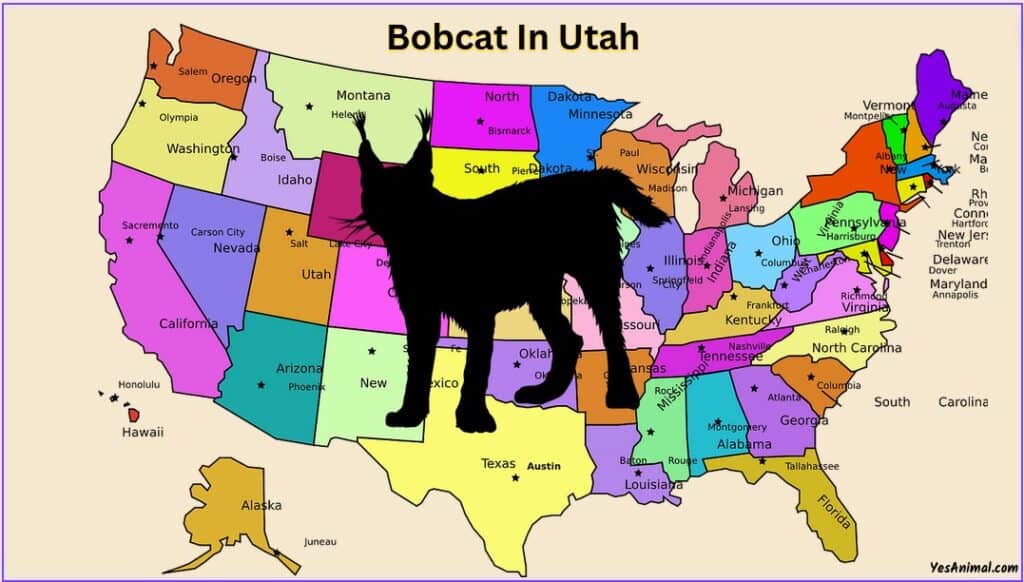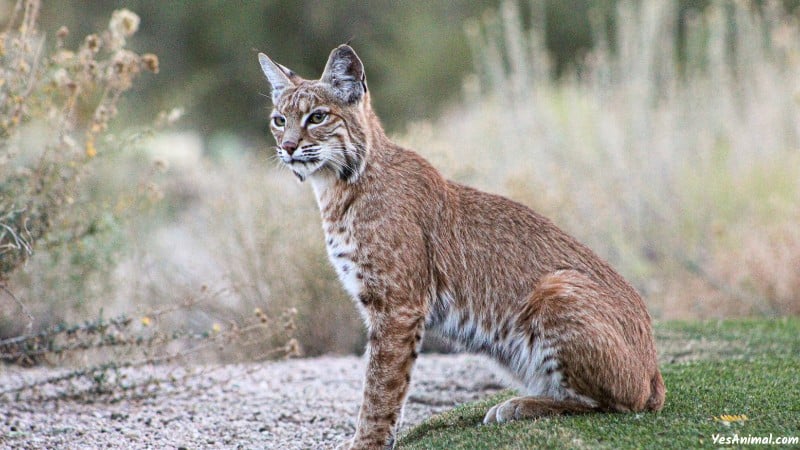Last Updated on September 14, 2023 by Amin Tawar

If you have lived in Utah for more than a year, I am sure you would have spotted at least one of the wildcats found in the state. In this article, we are going to look at the most abundant wild cat not only in the state but also across the North American continent itself.
Yes, I am talking about the omnipresent Bobcats. They are members of the Felidae cat family and in general, have features and characteristics similar to that of domestic cats.
While they don’t pose a serious threat to humans, they do have a vital role to play as one of the top predators of their ecosystem. So, makes sense to know about their presence, characteristics, and legalities pertaining to Bobcat ownership and hunting in Utah.
Are There Bobcats in Utah?
Yes, there is a stable population of Bobcats in Utah. Bobcats are scientifically called Lynx rufus and are a distant cousin to Canada Lynx which is currently not found in Utah. Their fur color varies from reddish brown to gray which helps them camouflage in all different seasons.
There was a time in the distant past when the Bobcat population gradually declined. But due to various conservation efforts from the state’s wildlife agency, their population has been restored.
Where Do Bobcats Live in Utah & How common are bobcats in Utah?
Bobcats are adaptive and can therefore be found in various habitats across the state. In fact, bobcats are found in all 29 counties of the state.
From deserts to mountain regions, bobcats prefer habitats with a dense cover so that it’s easier for them to hide. This degree of reclusiveness is seen in almost all of the wildcats including mountain lions and big cats like tigers, lions, etc.
Additionally, bobcats are also very varying of human presence and avoid them at all costs. This is why, though there are a good number of Bobcats in the state, it is still difficult to spot them owing to their solitary nature.
How Large Is a Utah Bobcat?

Be it in Utah or any other state of the country, Bobcats found are of similar size albeit with small variations.
In general, Bobcats are about double the size of our neighborhood pet cats. But they are significantly smaller than other wildcats like mountain lions, and Canada Lynx which in fact makes them the smallest wild cats that can be seen. On average adults’ bobcats weigh anywhere between 12 to 30 pounds with the male being larger than their female counterparts.
As per various sightings and studies conducted on bobcats, they measure about 2 to 4 feet in length and about 2 to 3 feet in height from the shoulder. Their paws are also big and help differentiate between a bobcat print and a domestic cat print in the wild.
Also Check Our Guide On Bobcats In US
Are Bobcats Aggressive in Utah?
Bobcats like their cousins, aren’t aggressive most of the time and there also haven’t been any reports of Bobcats attacking humans in the state. But we shouldn’t write off aggressiveness in bobcats as at the end of the day, they are wild creatures that are capable of exhibiting potentially dangerous behaviors.
Especially when they are cornered or threatened, bobcats will behave defensively and exhibit aggressiveness in some cases. Additionally, they may have conflicts with humans due to food and their presence near kittens. Therefore, always be cautious and respect a bobcat’s space just as you would for another human.
What Do Bobcats Eat in Utah?
A wild animal’s diet predominantly depends on the type of prey found in its habitat. Bobcats are carnivores by nature and in general eat small mammals.
Their diet depends on the prey found in their environment but mostly consists of rabbits, rodents, insects, and small reptiles. As they are opportunistic hunters, they also often eat dead animals and hunt weak deer.
Can You Kill a Bobcat in Utah?
Yes, you can kill a bobcat with a valid permit and license. As per the Utah Division of Natural Resources, bobcats are protected and designated as fur-bearing animals. Their population is managed through licensed trapping season which is conducted between November to March in general. Outside this season, it is illegal to hunt these furbearers.
As a wildlife service agent, you don’t need a permit to remove or harvest a bobcat as long as you follow the rules set by the Utah Division of Natural Resources.
If you are a resident of the state and want to hunt or trap a bobcat, you need to obtain a furbearer license, bobcat permit, and trap registration license.
Can You Own a Bobcat in Utah?
As Utah Bobcats are classified as furbearers, it is illegal to own them, especially as pets. Only licensed game breeders are permitted to possess them for breeding and hunting purposes. It is also important to note that possession of Bobcats is strictly regulated even for game breeders.
Wildlife regulatory laws may change in the future, and it may be legal to own them then. So, always follow the latest regulations and rules set by the wildlife agency before making the decision to own them.
Also, when you are considering, do know that bobcats are wild creatures and may not be suitable in a domestic scenario. Be prepared to give your time in taking care of it and being cautious of its behaviors.
What To Do If You See a Bobcat in Utah?
Bobcats all over the world are rarely dangerous. They often don’t pose an immediate threat to humans and only occasionally are known to predate on livestock. However, it is always good to be safer than sorry.
Firstly, avoid their presence in your localities by securing food sources inside, keeping pets indoor,s and monitoring them outdoors. If you do end up spotting them near you, make loud noises if they haven’t noticed you, maintain a safe distance, and avoid feeding them at all costs.
If unluckily, the bobcat in the picture shows dangerous behavior and is threatening your pet or livestock’s life, immediately contact the Utah Division of Wildlife Resources. An agent will be sent to resolve the issue.
Also Check Our Guide On Bobcats In Oregon
Conclusion
And that was everything you need to know about the Bobcats in Utah. I hope this article was infromative and your queries were answered.
Thank You For Reading!
Our Goto Source For This Guide